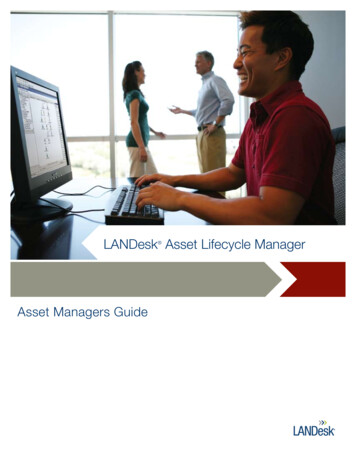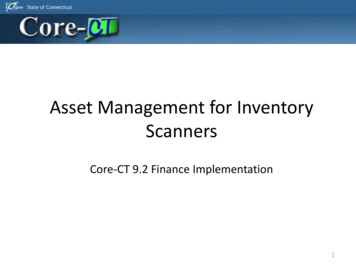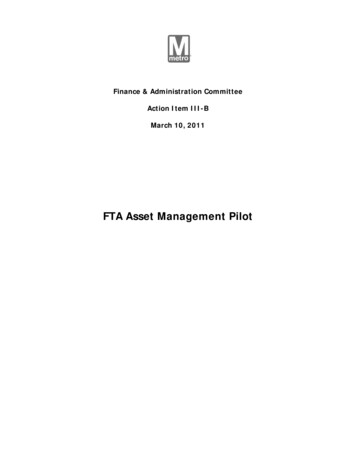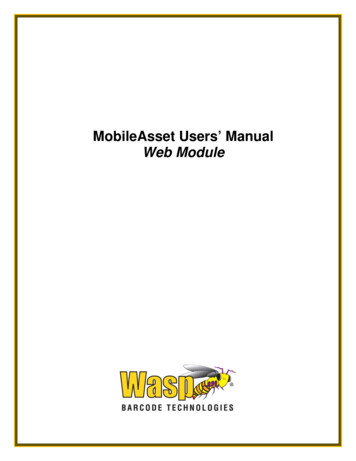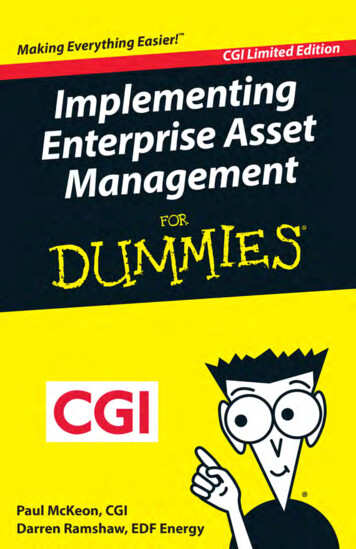
Transcription
ImplementingEnterprise AssetManagementFORDUMmIES‰by Paul McKeon, CGI andDarren Ramshaw, EDF EnergyA John Wiley and Sons, Ltd, Publication
Implementing Enterprise Asset Management For Dummies Published byJohn Wiley & Sons, LtdThe AtriumSouthern GateChichesterWest SussexPO19 8SQEnglandFor details on how to create a custom For Dummies book for your business or organisation, contactCorporateDevelopment@wiley.com. For information about licensing the For Dummies brand forproducts or services, contact BrandedRights&Licenses@Wiley.com.Visit our Home Page on www.customdummies.comCopyright 2013 by John Wiley & Sons Ltd, Chichester, West Sussex, EnglandAll Rights Reserved. No part of this publication may be reproduced, stored in a retrieval system ortransmitted in any form or by any means, electronic, mechanical, photocopying, recording, scanningor otherwise, except under the terms of the Copyright, Designs and Patents Act 1988 or under theterms of a licence issued by the Copyright Licensing Agency Ltd, 90 Tottenham Court Road, London,W1T 4LP, UK, without the permission in writing of the Publisher. Requests to the Publisher forpermission should be addressed to the Permissions Department, John Wiley & Sons, Ltd, The Atrium,Southern Gate, Chichester, West Sussex, PO19 8SQ, England, or emailed to permreq@wiley.com, orfaxed to (44) 1243 770620.Trademarks: Wiley, the Wiley logo, For Dummies, the Dummies Man logo, A Reference for the Restof Us!, The Dummies Way, Dummies Daily, The Fun and Easy Way, Dummies.com and related tradedress are trademarks or registered trademarks of John Wiley & Sons, Inc. and/or its affiliates in theUnited States and other countries, and may not be used without written permission. All othertrademarks are the property of their respective owners. John Wiley & Sons, Ltd, is not associatedwith any product or vendor mentioned in this book.LIMIT OF LIABILITY/DISCLAIMER OF WARRANTY: THE PUBLISHER, THE AUTHOR, ANDANYONE ELSE INVOLVED IN PREPARING THIS WORK MAKE NO REPRESENTATIONS ORWARRANTIES WITH RESPECT TO THE ACCURACY OR COMPLETENESS OF THE CONTENTS OFTHIS WORK AND SPECIFICALLY DISCLAIM ALL WARRANTIES, INCLUDING WITHOUTLIMITATION WARRANTIES OF FITNESS FOR A PARTICULAR PURPOSE. NO WARRANTY MAYBE CREATED OR EXTENDED BY SALES OR PROMOTIONAL MATERIALS. THE ADVICE ANDSTRATEGIES CONTAINED HEREIN MAY NOT BE SUITABLE FOR EVERY SITUATION. THIS WORKIS SOLD WITH THE UNDERSTANDING THAT THE PUBLISHER IS NOT ENGAGED IN RENDERINGLEGAL, ACCOUNTING, OR OTHER PROFESSIONAL SERVICES. IF PROFESSIONAL ASSISTANCEIS REQUIRED, THE SERVICES OF A COMPETENT PROFESSIONAL PERSON SHOULD BE SOUGHT.NEITHER THE PUBLISHER NOR THE AUTHOR SHALL BE LIABLE FOR DAMAGES ARISINGHEREFROM. THE FACT THAT AN ORGANIZATION OR WEBSITE IS REFERRED TO IN THIS WORKAS A CITATION AND/OR A POTENTIAL SOURCE OF FURTHER INFORMATION DOES NOT MEANTHAT THE AUTHOR OR THE PUBLISHER ENDORSES THE INFORMATION THE ORGANIZATIONOR WEBSITE MAY PROVIDE OR RECOMMENDATIONS IT MAY MAKE. FURTHER, READERSSHOULD BE AWARE THAT INTERNET WEBSITES LISTED IN THIS WORK MAY HAVE CHANGEDOR DISAPPEARED BETWEEN WHEN THIS WORK WAS WRITTEN AND WHEN IT IS READ.Wiley also publishes its books in a variety of electronic formats. Some content that appears in printmay not be available in electronic books.ISBN: 978-1-118-48538-5; ISBN: 978-1-118-48540-8 (ePDF)Printed and bound in Great Britain by Page Bros, Norwich10 9 8 7 6 5 4 3 2 1
IntroductionHave you ever wondered how modern society wouldfunction without the machinery, equipment and infrastructure that surrounds it? How would life be without newapps for your iPAD, no running water, no reliable electriclighting? How would society get by without planes, trains,road networks, shipping and haulage, pressurised watersupply, telecommunications, cloud-computing, electricity,pressurised gas supply, sewerage services, mass-manufactureand refining and processing plants? Life would certainly bevery different.The reality is that wherever, as a society, we have createda reliance on machinery, equipment and infrastructure todeliver advances for humankind, we’ve also created a needfor the effective management of these physical assets. As thenumber of mobile phone users globally reached the six billionmark in 2011, and with the investment of governments andmotor manufacturers in electric cars, the reliance on furthernew technologies still shows no sign of slowing.As a direct consequence of this reliance, Enterprise AssetManagement is a central concern for many enterprises andgovernment policy makers today.So what’s new? Surely we’ve been managing assets for thousands of years? The Romans built aqueducts, roads andviaducts that have lasted for millennia. Many of the otheressentials of modern life – electricity, gas supply, manufacturing, sewerage and so on – have been around for at least a century. So what’s different from how we’ve been managing andmaintaining these assets?Unlike the Romans who could afford immense overdesignon their equipment or the builders of the Brooklyn Bridge inthe late 19th century who designed suspension cables to besix times greater than needed, our safety margins are fractional today. We’ve stripped our planet of readily available
2Implementing Enterprise Asset Management For Dummiesresources and have to pay a premium price for what remains.More humans are alive today than have ever lived since thedawn of time, which makes the demand for resources evergreater – for example, we’re close to running out of infrastructure for power generation to meet the needs of all theseresources. This situation places further importance on themanagement of the assets that bring those resources to us.As a result, assets need to do more for less investment over alonger time period.And finally, while we don’t yet live in towering verticalmega-cities (in case you think we’re joking, search online for‘arcologies’), the interdependence of assets on one anotheris already very complex in our society. Just consider smartgrids, smart meters, fly-by-wire airline navigation and so on.As an example, think how complicated it is to dig a hole inthe ground in London, a city that has been rebuilt many timessince it was razed to the ground by Boudicca almost 2,000years ago. Therefore, the effects of poor asset managementgrow rapidly over time.With many governments struggling with the recession andmany businesses trying to ride out the economic storm,the last thing you need is for unexpected losses and costsrelated to machinery, equipment and infrastructure failures.To weather economic cycles of growth and recession, assetintensive organisations are best placed to succeed when theirasset outcomes (performance, reliability and cost-effectiveness) are superior to their rivals.The modern asset manager needs to achieve more challengingasset outcomes against a backdrop of ever-increasing regulation and financial constraint. To reach this goal, the implementation of Enterprise Asset Management (EAM) needs tobe designed to gain the most synergies across the enterprise.Implementation means challenging age-old practices and pulling together resources to get greater efficiencies with betteroperational performance and financial transparency. Like thedesign of your complex assets, much of the lifetime run costsof Enterprise Asset Management within your organisation arebaked in from the start, so getting it wrong isn’t much of anoption.
Introduction3About This BookThis book offers answers to today’s challenges. For those ofyou familiar with Smart Metering For Dummies, Smart GridsFor Dummies and New Nuclear Power For Dummies, you knowwhat to expect: namely a concise primer to get you rapidlyup to speed with business context, terminology, impactsand issues related to the implementation of Enterprise AssetManagement.The topic of asset management is vast, so this book relates toEnterprise Asset Management, addressing a slightly narrowersubset of organisations than wider asset management does.The book focuses only on large asset-intensive enterprisesrather than all organisations. For this reason, while we referto standards in asset management throughout the book, weonly mean within this smaller group of large enterprises –hence the term Enterprise Asset Management.Asset management is also an area where thinking is movingon quickly with global collaboration being driven by organisations like the Global Forum on Maintenance and AssetManagement (GFMAM), the Asset Management Council (AMC)and the Institute of Asset Management (IAM). There’s alsoconvergence of thinking through PAS 55 and ISO 55000. Youmay be surprised to realise that PAS 55 has been in existenceonly since 2004. Therefore, this book aims to function as asignpost and handy guide on the topic of the emergence andimplementation of Enterprise Asset Management.Foolish AssumptionsIn writing this book, we made some assumptions about you,the reader. We assume that: You work in an asset-intensive industry and understandthe need for implementing good EAM practice to achieveimproved asset outcomes. You’re interested in management of physical assets(including the financial aspect) as opposed to the management of purely financial assets (such as derivatives,bonds and so on).
4Implementing Enterprise Asset Management For Dummies You appreciate the difference between implementingEnterprise Asset Management and implementing an EAMIT system. This book focuses on implementing EnterpriseAsset Management to meet your overall business needs,although we do reference IT system considerations. You want to know more about the techniques andapproaches for EAM implementation taken by other successful asset managers. You want to know how you can tune your EAM implementation to achieve, track, maintain and improvecompliance with standards and external bodies (bothregulatory and statutory). You’re interested in harnessing the efforts of previouslydisconnected groups across your enterprise towards theachievement of better asset management. You understand some asset management jargon (butdon’t worry – we include a glossary at the back of thebook, just in case).How This Book is OrganisedImplementing Enterprise Asset Management For Dummies isdivided into five informative parts: Part I – Defining Enterprise Asset Management(EAM): We explain what we mean by Enterprise AssetManagement, why you should implement EAM and whatgood EAM looks like. Part II – Finding the Right EAM Approach: We describethe key ingredients of an EAM strategy, including definingappropriate asset policy, marshalling the right people,process and system resources and discussing how youcan measure your progress along the pathway to success. Part III – Designing Your EAM Vision: We examine themeasures necessary to embed the vision in your peopleand build the foundation, including effective leadership,integrated processes, the holistic mindset, suitable systems and a one-team mentality.
Introduction5 Part IV – Implementing EAM: We explain the measuresnecessary for EAM implementation (with continuousimprovement) programmes, including performancetracking, organisational (re)design points and importantimplementation behaviours and activities. Part V – Top Ten Implementation Points to Remember:If you read nothing else, this part lists the essential thingsto bear in mind when discussing EAM implementation.Icons Used in This BookTo make navigation to particular information even easier, theseicons highlight key text:The knotted string highlights important information to bear inmind.The For Dummies man indicates a real-life example to illustratea point.This icon marks the place where technical matters are highlighted and where you might need to think a little more carefully about something.Where to Go from HereAs with all For Dummies books, you can dip in and out of thisbook at any point you like or read it from cover to cover – itwon’t take you long!Use the headings to guide you to the information you need.If you require more information, feel free to contact us atenergyandutilities.uk@cgi.com.
Part IDefining Enterprise AssetManagement (EAM)In This Part Getting the inside scoop on EAM Understanding what EAM encompasses Looking at EAM’s scales and objectives Realising the benefits of EAMIn this chapter, we tell you exactly what we mean byEnterprise Asset Management. We look at the componentparts of EAM and then look at the overall scope of EnterpriseAsset Management.Figuring Out What EAMShould DoYou probably know what the words enterprise, asset and management mean, but you may wonder what they meanwhen used together.So what is an asset? Ask yourself: do you need to inspect it,maintain it, attribute costs to it or need to know how it’s performing? If yes, then you can probably consider it an asset.In this book, assets refer to physical objects, such as roads,rail tracks, plants, gas pipelines, water mains, buses, aircraft,trains, buildings and all subtypes of plant and equipment.
Part I: Defining Enterprise Asset Management (EAM)7For more detailed definitions of asset management, pleasesee the websites of the Institute of Asset Management (IAM;www.theiam.org) and the European Federation of NationalMaintenance Societies (EFNMS; www.efnms.org).Enterprises are any big organisations that depend on largeamounts of physical equipment or assets. We call these companies asset-intensive organisations.For our purposes, asset management is the set of activitiesthat an organisation performs in order to achieve the optimum performance of their assets in line with its objectives.This includes procurement, design, finance, risk management,human resources, operations and maintenance.Enterprise Asset Management is the focusing of enterprise-widetime, effort and resources to achieve optimal total businessimpact through the performance of its assets.The IAM in particular, through BSI PAS 55: 2008, provides therequirements for asset management. These requirements areregularly used across asset-intensive industries to audit anorganisation’s asset management practices.Examining the Scope of EAMEAM balances the many disciplines (for example, engineering,finance, risk and so on) that lead to optimum performance ofour assets. For example, having the best performing assetsdoesn’t do you much good if you can’t use them becausethey’re always being maintained; likewise, having a lot ofunexpected failures due to lack of maintenance means thatyour assets aren’t as reliable as they should be. As Figure 1-1shows, the aim is to strike a balance between operation ofyour assets and the costs of maintenance.In Figure 1-1, the arrow shows asset operation and maintenancebalanced for best business impact. To the left, maintenance istoo low leading to high operational losses due to failure of theassets. To the right, maintenance is too high leading to highoperational losses due to unavailability of the assets.
8Implementing Enterprise Asset Management For DummiesFigure 1-1: Impact of asset management approach on the balance betweenasset availability and cost.The preceding example focuses only on the operational lifephase of your assets. However, Enterprise Asset Managementtakes into account the whole lifecycle, including: Design Procurement and construction Commissioning Operation Decommission and disposalThe objectives of each phase can have detrimental effects onthe other phases – for example, if two metres of clearance isneeded to maintain an asset when it’s designed, but in therush to complete construction, the building has less than onemetre clearance, then maintenance costs are higher.So the scope of Enterprise Asset Management encompassesall the lifecycle of the asset.Asset Management Comes of AgeOnly recently, an international consensus on asset management has been reached. This has laid the foundation for a newISO 55000 standard for asset management replacing PAS 55.
Part I: Defining Enterprise Asset Management (EAM)9The consensus is presented as a convergence of the disciplines mentioned in the preceding section with a core of 39subjects – see www.theiam.org for details.While we don’t attempt to deal with these topics in detail, wedo refer to them throughout this book.Understanding the Scale andObjectives of EAMAssets may range from small discrete assets in remote locations to larger complex plant-type assets. Enterprise AssetManagement aims to provide the appropriate regime for thebest management of the asset in accordance with its valueand the importance of its role to the organisation.In addition to balancing an asset’s maintenance cost and operational availability, we need to look at how the decision toinvest in an asset kicks into motion a whole sequence of interdependent activities over the asset lifecycle. This relationshipis shown in Figure 1-2.Figure 1-2: Enterprise-wide dependencies in asset management.
10Implementing Enterprise Asset Management For DummiesFigure 1-3 lists the individual dependencies from Figure 1-2.Figure 1-3: Table of dependencies in asset management.
Part I: Defining Enterprise Asset Management (EAM)11Everything’s relatedWhen you consider the scale of Enterprise Asset Management,you also need to think about the whole lifecycle, as well as thedependencies between lifecycle activities.The scale of asset management therefore depends on theasset to be managed, its criticality when supporting operations, its lifecycle and the consequences of its failure.You need to make many key decisions during an asset’s life,and these decisions all have downstream impacts. For example: The design of the asset determines its physical shape,which determines how easy or hard it is to maintain,which affects the cost to maintain. Profit (or regulatory funding) finances all support activities relating to asset management.Choosing smart objectivesChoosing the right objectives is essential when defining howperformance is to be measured.In his book Strategic Asset Management (TroubadourPublishing Limited), Clive Deadman surveyed a number ofUK-based asset-intensive organisations and presents his findings, which demonstrate current practices. These findingsillustrate setting objectives in asset-intensive organisationsand led to the development of a strategic hierarchy of assetmanagement activities, which is depicted in Figure 1-4.An organisation that has correct asset management objectiveswill have all the business pulling in the right direction.
12Implementing Enterprise Asset Management For DummiesClive Deadman, Troubadour Publishing Limited.Figure 1-4: Strategic hierarchy of asset management activities.Objectives need to flow down through the organisation, asshown in Table 1-1.Table 1-1 Example of How Objectives Should Flowthrough an OrganisationObjective LevelObjective DescriptionLevel 1 objectiveMaximise plant production.Level 2 objectiveReduce business impact of asset failure by prioritising care of critical assets.Level 3 objectiveProtect asset reliability with appropriate maintenance strategiesORImprove asset reliability by designing out flaws.Level 4 objectivePrioritise preventative work to ensure maintenance strategy is achieved.
Part I: Defining Enterprise Asset Management (EAM)13Knowing the Benefits ofImplementing EAMYou have several good reasons to consider implementingEAM because it: Promotes cost-effective business management. Reduces risk of critical asset failure and therefore overallorganisational risk. Provides workers with a safer work environment. Gives workers a safer set of processes to work with. Promotes environmental, regulatory and statutory compliance as standard practice.The fundamental reason why organisations implement assetmanagement is because it makes good business sense. Allasset-intensive organisations need an ordered, structured,disciplined way of controlling assets.Identifying Good EAMThe measures of good EAM are tied to the measures of goodbusiness performance. For some organisations, OverallEquipment Effectiveness (OEE) may be a useful measure. OEEmultiplies equipment Availability Performance Quality togive an OEE score.Other organisations may measure their EAM performance interms of their customers’ experience, which is based on theirasset performance. The actual measures are specific to theindustry and business type. For example, failure of glass windows on commuter buses is an inconvenience, while failure ofglass windows on planes may be catastrophic.Therefore, each organisation should look to benchmark itsEAM behaviours against its peers first and then against organisations where EAM is more critical to its existence. Analystreports such as Gartner, Forrester, Ovum and AberdeenGroup can be useful in this area.Ultimately, good EAM practices are common across industries, even though specific measures may differ.
14Implementing Enterprise Asset Management For DummiesBerneslai Homes monitors continuousimprovementBerneslai Homes is a small housing management and maintenanceorganisation affiliated to BarnsleyCouncil in the UK. In 2002, it identified that regulatory improvementswere needed in the management of21,000 houses, and the organisationembarked on the implementation ofEAM. CGI helped Berneslai Homeswith the organisational change, process changes and implementation ofnew systems both in the back-officeand for field workers. BerneslaiHomes measured the improvementsfrom 2005 onwards (when the initiatives started to go live), and thesemeasurements provided hard factson the success of its implementation.These hard facts (as well as providing indisputable proof for the benefits for implementation of EnterpriseAsset Management) helped justifythe continuation of the programmefor ongoing improvements.The project referenced in this example, and all examples in this book,was delivered by Logica which CGIacquired in August 2012.Steps to successYou can strategise all you like, but if you don’t have a plan toget from A to B, then you won’t get any improvement in assetoutcomes. This book provides guidance in this area.
Part I: Defining Enterprise Asset Management (EAM)15The Aberdeen Group, in its 2009 paper entitled ‘AssetPerformance Management – Aligning the Goals of the CFOsand Maintenance Managers’, identifies steps to success forasset-intensive organisations.When an organisation is trying to move its asset management performance from laggard (below industry-average) toindustry-average or industry-average to best-in-class, certainactions, shown in Table 1-2, can help spur the necessary performance improvements.Table 1-2Identifying Where Your Organisationis Starting FromLaggard Steps toSuccessIndustry-AverageSteps to SuccessBest-in-Class Steps toSuccessUtilise energy conEstablish execuEstablish a risk- tive focus for asset management strategy sumption for operafor predictive decision- tional decision-makingmanagementmakingProvide real-timeand historicalasset data toemployeesAlign goals and metrics across maintenance and productionteamsSynchronise asset performance to corporateperformanceInvest in analyticsEstablish integrationbetween EAM and theplant floor as well asbusiness systemsImplement reliabilitycentred maintenanceas a primary maintenance approachWhat good EAM looks likeGood Enterprise Asset Management manifests itself in manyways: Management of risk associated with assets is built intoeverything a high-performing, asset-intensive organisation does. The organisation makes focused, holistic use ofresources to optimise asset performance. A culture is created where the entire business understandshow driving more from assets helps achieve success.
16Implementing Enterprise Asset Management For Dummies A learning organisation results where the understandingof the root causes of failures is continually fed back intoprocesses and procedures for higher performance assetswith reduced unexpected failures. Cost-effective, efficient compliance occurs with statutory,mandatory and regulatory standards. An organisation is created where planned maintenancetakes priority and reactivity is resisted. An organisation effectively prioritises emerging work. An organisation maintains strategy conformance andhigh asset performance, and a low cost of asset management when compared with its peers.Good EAM isn’t easily distinguishable from good businessmanagement because best practice EAM is part of the day-today activities of the best-run organisation.
Part IIFinding the RightEAM ApproachIn This Part Getting your EAM approach in sync with your business strategy Knowing where to beginIn this chapter, we look at getting the right EAM approach inplace for the organisation. In doing so, we assume the useof PAS 55 as a specification for Enterprise Asset Managementgood practice. Therefore, you may want to refer to PAS 55 formore detailed information. (See the nearby sidebar for information on PAS 55.)What is PAS 55?BSI PAS 55: 2008 comprises: Definition of terms in assetmanagement Requirements specification forgood practice Guidance for the implementationof such good practicePAS 55 provides objectivity across 28aspects of good asset management,from lifecycle strategy to everydaymaintenance (cost / risk / performance). It enables the integrationof all aspects of the asset lifecycle: from the first recognition of aneed through to design, acquisition,construction, commissioning, utilisation or operation, maintenance,renewal, modification and/or ultimate disposal.
18Implementing Enterprise Asset Management For DummiesAligning Your EAM Approachwith Your Overall BusinessStrategyYour vision for how the organisation will run its EAM is basedon driving towards achieving the good EAM attributes identifiedin Part I. Therefore, you can start to set in motion the actionsnecessary to achieve good EAM by defining your approach.Align your EAM approach to the overall business strategy. Inaccordance with PAS 55, ‘The organisation’s top managementshall authorise an overall asset management policy’ that isaligned with ‘the organisational strategic plan’.Establishing policiesTo optimise business performance against the backdrop ofcustomer demands, a strong focus on risk associated withEAM is essential. Management of risk associated with assets iscentral to everything a high-performing organisation does andis reflected strongly in its asset management policy.The establishment of the asset management policy is important because it: Is aligned with business strategy and confirms the organisation’s commitments related to its assets. Ensures that the organisation’s asset management policyis aligned with wider organisational policies, includingrisk management, environment health and safety andregulatory, legislation and statutory compliance. Provides the foundation for the asset strategy, objectivesand plans. Commits to continual improvement in asset managementand asset management performance.As the key definition document, it’s essential that the assetpolicy is controlled, communicated and reviewed as appropriate. This may include internal and external stakeholders, suchas the Health and Safety Executive (HSE).
Part II: Finding the Right EAM Approach19Conforming to standardsEAM documentation needs to cross-reference PAS 55 toensure active compliance. PAS 55 prescribes the definition ofan asset management policy and an associated strategy.The following is an example of an asset management policythat illustrates the things that may be contained in a workingEAM policy. (This list will vary by organisation, and we provide it here simply for illustrative purposes.) Designing, constructing, operating, maintaining anddisposing of enterprise assets to ensure compliance toapplicable legislative requirements and high standardsof health, safety, environmental and commercial performance throughout their complete life. Ensuring that the enterprise’s total supply chain risks areidentified and that relevant policies and procedures arein place to mitigate identified risks. Measuring and improving the effectiveness of the enterprise’s approach to asset management by continuousreview and adjustment as required. Enabling employees to have the competencies necessaryto effectively deliver asset policies and procedures. Communicating all necessary information to the relevantstakeholders to enable delivery of asset managementpolicy and procedures. Identifying the risks inherent in assets that may preventthe delivery of stakeholder needs and develop optimumasset strategies to mitigate identified risks. Managing all the enterprise assets in a way that optimises whole life costs. Developing short- and long-term performance targets forassets that optimise the use of resources. Developing and maintaining an approach to data management that can underpin asset decision-making by promoting cooperation, consultation and communication ofknowledge. Developing and maintaining asset plans that enable theasset policy objectives to be delivered.
20Implementing Enterprise Asset Management For DummiesAfter the policy is defined, the asset manager is required toderive a strategy leading to plans and objectives to definehow the organisation will perform asset management.The nearby sidebar shows an example of an asset management strategy (this strategy will vary by organisation).The important thing is that the strategy and policy works fortoday’s organisation. And this is where the fun starts . . .Defining the objectives of the asset management initiative isall very well, but it’s an entirely different thing knowing howto get there.However, PAS 55 isn’t the only standard. Other standardsinclude ISO 9001 (Quality), ISO 14001 (Environmental), OHSAS18001 (Health and Safety) as well as a host of engineering andfinancial standards, such as Generally Accepted AccountingPractices (GAAP).An asset management strategyEnterprise Asset ManagementStrategy example:ObjectivesAchieve World Class Asset Manage ment with: Streamlined RCM maintenancep
Implementing Enterprise Asset Management For Dummies Published by John Wiley & Sons, Ltd The Atrium Southern Gate Chichester West Sussex PO19 8SQ England For details on how to create a custom For Dummies book for your business or organisation, contact CorporateDevelopment@wiley.com. For information a






